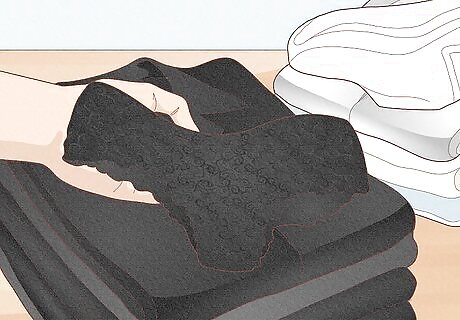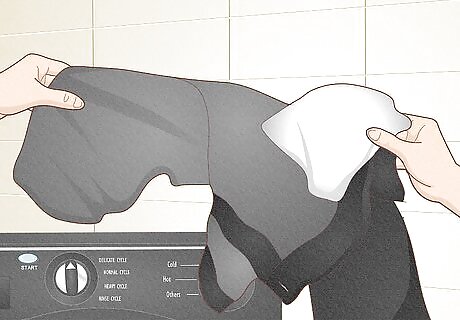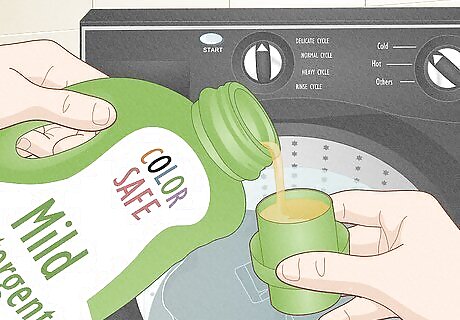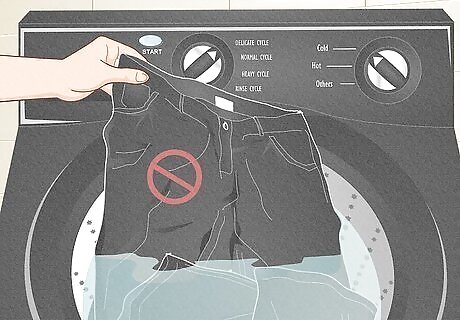
views
Read your clothing labels.

Check for specific washing and drying instructions on each item. Reading labels is always a good precaution, regardless of what you’re washing. Ensure your clothing is machine washable (since not all clothing is), and you know the best way to wash each article. Expensive clothing (like a black business suit, for example) may be dry-clean only, meaning you’ll have to take it to the dry cleaners. Other clothing, like wool clothing, may be hand-wash only. Wash those items in a sink or tub with a small amount of detergent; then, rinse them and then hang them or lay them flat to dry. Care tags are there for a reason! Following their instructions can keep your dark and black clothing looking new for longer.
Sort your clothing.

Separate items based on color and fabric type. Dark clothes (black clothes especially) can bleed onto lighter shades in the wash. Go through your dirty laundry piece by piece; create one pile for dark-colored clothes and one for light clothes. Then, separate the piles again by fabric type; wash heavier fabrics (like jeans and towels) separately from lighter fabrics (like t-shirts). Remember: just because you have a pile of dark clothing doesn’t mean they should all be thrown into the wash together. Fabric type can affect the type of wash a piece of clothing needs! If possible, Put delicates (like lacy underwear and bras) in their own pile and wash them separately. Consider how dirty each piece of laundry is. Don’t wash super dirty clothes with items that only need a light wash. Sorting your dark clothing before washing can also protect the fabric from lint and pilling, which can make it look faded and aged.
Turn clothes inside out.

Protect your clothing from damage or fading in the wash. Wash cycles can agitate dark fabrics, which causes a faded appearance—and while some fading is inevitable, you can at least make dark outfits last longer by turning them inside out before washing them. Be sure to pre-treat any stains before washing dark clothing. Pre-treatment gets rid of stains in the first washing (meaning you won’t have to re-wash your dark clothes in a hurry).
Wash your clothes with cold water.

Cold water prevents dark clothes from fading. Dark clothing is particularly susceptible to losing color during a wash cycle, which is why cold water is preferable; it helps the fibers in dark fabrics stay intact. Set your washing machine to the coldest setting possible. If your clothing is especially dirty, use the soil setting— but set it at the lightest possible level. Hot water can make clothing fade faster (and using cold water for washing clothes actually saves money—and energy—as well).
Use a delicate wash cycle.

Shorter cycles are less likely to cause fading. Always select the shortest and most delicate cycle possible for a load of dark clothing; the less time dark clothes are in the washer, the better. This will help them maintain their color! Delicate fabrics (like undergarments and bras) also need special care, so use the gentlest cycle available and mesh lingerie bags to protect them. Be extra vigilant about reading labels when it comes to delicates. Many types of lingerie and expensive bras are hand wash only. Additionally, do your best not to overload your washing machine; it’s best if your clothing can move around freely while being cleaned.
Choose a basic, bleach-free detergent.

When possible, use liquid detergents designed for dark clothing. Look for a laundry detergent that doesn’t advertise any additives on the package; it should be safe for your darker clothes. Some items might be labeled “color safe,” but don’t use them on dark or black clothes; they’re generally better for light-colored clothing. Liquid detergent is preferable to powder because it prevents residue from being left of your clothes. Add the detergent of your choice to the washing machine before dropping your clothing in; pouring detergent over clothing might leave spots or stains. Worried your dark clothing is looking too dull? Add ½ cup of white vinegar to the washing machine instead of detergent. Vinegar can seal in color and get rid of stains!
Measure detergent carefully.

Too much detergent can prevent clothing from getting fully cleaned. Before adding detergent to a load of dark clothing, read the package to see how much detergent to add. Every detergent is slightly different, so there’s no set amount to use (although less is usually more). When possible, use a small amount of concentrated detergent for dark clothing. If your clothing is heavily soiled, it’s okay to add a little extra detergent to the wash. This can help you get the job done the first time Remember, washing dark clothing always causes at least some fading, so an efficient wash is best.
Use fabric softener.

Fabric softener can reduce friction and prevent fading. When items of clothing don’t rub up against each other as much, they won’t fade so much either—plus, fabric softener can make clothing feel more fresh and soft with each wash. Many detergents come with fabric softener, so check if yours does. If not, it’s a good idea to throw some in with each load! This is especially important if you’re washing something like a towel, which tends to feel better when softened in the wash. If you have a fabric softener separate from your detergent, follow the instructions for how much to add to your wash. Keep in mind that some laundry machines have a separate dispenser where you can add fabric softener.
Air dry clean clothes.

Tumbling in the dryer can end up fading dark clothes. So, after removing your dark clothes from the wash, hang them out to dry—ideally in your laundry room or somewhere indoors. Avoid drying dark clothing in direct sunlight since sun exposure can cause them to fade (though if you have an outdoor clothesline out of direct sunlight, you could use that). Remember not to hang sweaters, however. Sweaters should be laid on a flat surface to dry! It’s okay to use a dryer and tumble your clothing dry if needed—but to prevent fading, use your dryer’s tumble dry setting without heat.
Wash dark clothes sparingly.

Dark clothing loses a little color every time you wash it. Denim, especially, has black dye that washes away during each wash cycle. So, don’t wash dark clothes as often as the rest; only wash clothing that’s very dirty or starting to smell. Many times, clothing with a small stain that’s clean otherwise doesn’t need to be washed at all! Small stains can usually be treated without a washing machine. Blot stains with a white cloth and a mixture of water and dishwasher detergent. Use ½ cup of water and 1 teaspoon of detergent. After blotting out the stain, rinse the area by blotting it with plain water.
Use bleach only when necessary.

Bleach can easily stain dark clothing. On some occasions, you may need bleach for stubborn stains that don’t respond to other treatments. In those cases, be sure to choose a quality bleach labeled “color-safe bleach,” indicating that it’s safe for non-white fabrics, as well as chlorine-free since chlorine bleaches are more powerful (and used to whiten clothes). Your washing machine may have a bleach dispenser. If so, follow its instructions. If you don’t have a bleach dispenser, dilute the bleach on your own (and read the package label for instructions). Only use bleach after running out of other options. Dark clothing should be bleached infrequently, if at all.




















Comments
0 comment